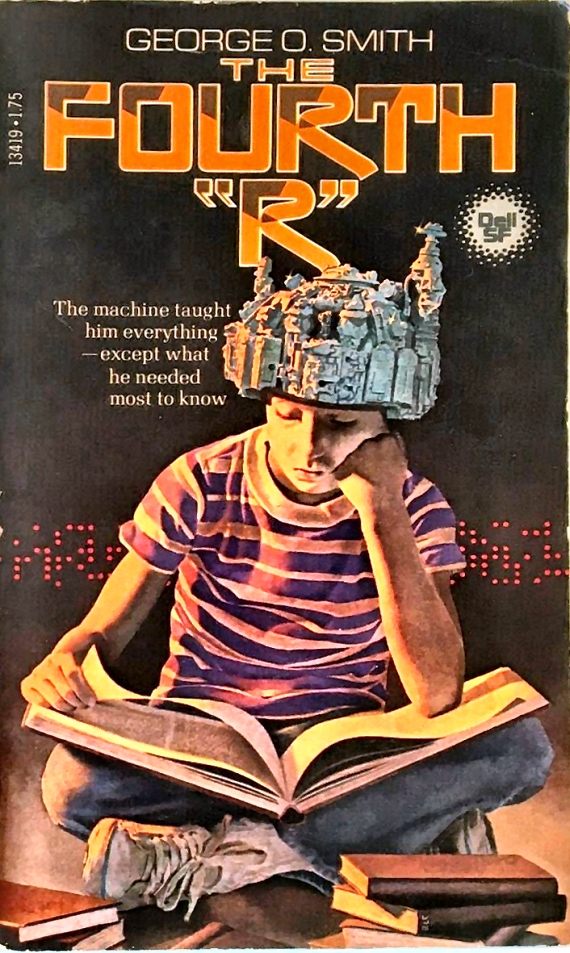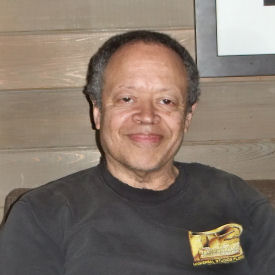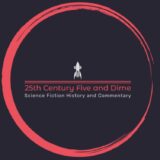
I’ve been reviewing a lot of movies, lately—because I’ve been a stone movie fan since about the age of 10—but it’s time to get back to reviewing books for a bit. I decided to do a retro review for a couple of reasons: first, because I’m becoming “youth-challenged,” and as with a lot of people my age, I look backwards towards things I enjoyed as a kid; secondly, because if an enjoyable book disappears from the online and offline (“brick and mortar”) stores, it may never be seen again by the general public. So, as (I think) Archy the cockroach says, “Wotthehell.” As a much younger person, I enjoyed the few George O. Smith (Oliver was his middle name) books I read. In those days (pre- and post-1960s), my access to books was limited to the libraries (school and public) and friends’ collections. And the ones I found at the Salvation Army (“Sally Ann”) store. So of G.O. Smith, I knew about the books Nomad, Highways in Hiding, The Fourth “R,” plus The Complete Venus Equilateral. I really liked all these books, but was unaware of any others he’d written. But of all these books, my absolute favourite was The Fourth “R”—and for the same reason I loved Wilmar H. Shiras’s Children of the Atom. Can you guess why?

The answer is that both books dealt with really smart children. And because I considered myself one of those—maybe not as advanced as the kids in the books—the books spoke to me. I spent five-plus years of my pre-teen to teen years in a place that was not welcoming to “smart” children—and I was bullied at school (an old story to many of my readers, I’m sure) and beat up occasionally, though I got really good at running. But that was long, long ago, and I was wondering how this book would hold up now that I was an adult and had found and befriended my actual peers—people who were smart, educated, and were comfortable in the company of others like them.
But all that is preface to the book; let’s take a look. (The cover in Figure 1 is for the Ballantine edition; my physical copy is buried in the basement among boxes and shelves of books, so I have no idea who did it. The one I re-read is from Project Gutenberg, and it’s the 1979 Dell edition, rather than the first 1959 Ballantine book. By the way, pictures of George O. Smith are hard to find on the ’net. I had a choice of a much older picture of a younger George, or a much smaller picture of an older George; I went with the latter, enlarging and colouring it. Many of the pictures found on the ‘net were of George P. Smith, a Nobel laureate. And “my” George is not to be confused with George H. Smith, who also wrote SF, but who also wrote a lot of soft-core porn.)

The book concerns one James Quincy Holden, who is five years old when it opens; he has been at a birthday party hosted by his “uncle,” Paul Brennan. The evening ended with James’s parents, “Uncle” Paul, and James playing bridge (James and his father as partners); James won all but the last rubber. On their way home, as James queried his father’s play—why he bid the way he did on the last rubber—a car came across the center line and James’s father lost control. The car crashed, and James was thrown clear. After he regained consciousness but was unable to move, he witnessed his “uncle” ensuring that neither of his parents were going to survive the crash. His soi-disant uncle then searched for James amidst the underbrush (presumably to kill him too), but was foiled by the arrival of someone wanting to help look for survivors. James was discovered by the stranger and taken to a nearby hospital for observation.
The reason a five-year-old was able to play bridge and converse intelligibly with his parents about bridge strategy was that James’s father had constructed a machine, an electromechanical teaching wizard that could be used to quickly memorize facts without the painful rote learning most of us have to go through. The parents had had a child for the express purpose of seeing how well a “blank slate” would take to the facts instilled by the machine. James, though lacking experience, had a better education than most high-school graduates, at five. (The fourth “r” referred to in the title of the book is “rapid.” According to George, the book died on the shelves due to the fact that there was a prominent religious group that used the “Fourth R” cognomen; obviously his book was confused with theirs, dismaying both SF writer and publisher.)
Paul Brennan, seeing not only the monetary, but also the probable political benefits of such a machine, determined to have it for himself; he assumed that besides the machine itself, there would be circuit diagrams, manuals, etc., at the Holden house. And with the Holdens dead, he could claim authorship of all, thus assuring he would reap the rewards he desired. But James had been schooled by his father as well as the machine; escaping from the hospital (nobody expected a five-year-old to be savvy enough to get his clothes and escape), he made his way to his own house and destroyed the central circuit of the “mechanical educator, and all documents pertaining to its use and/or construction. James Holden was now the sole person on Earth who knew how to rebuild this machine, and Paul Brennan would have to keep him alive.
The book goes on to detail James’s attempts to escape the custody of Brennan; his successful attempts at writing “boys’ fiction,” and Brennan’s attempts to learn the secrets of the machine. Eventually, employing the subterfuge of typed letters from an unseen adult James escaped Brennan’s custody and set himself up as a hermit-like writer who transacted all dealings with the outside world by typewritten letters. Eventually, James hires a housekeeper with a young daughter—all through classified ads and mail—so that he can do to the daughter what had been done to him, so that he could have a companion of his own (approximately) age.
The book continues through James’s eventual discovery by Brennan, his machine being used in evidence in court and, finally, James Holden creates a small colony of advanced children who continue advancing.
Some of the writing is a bit clunky, but it’s all of its time. At some near future time I plan to do a column about George O. Smith’s other books. I still enjoyed this one after reading it. Again, it is very similar to Wilmar H. Shiras’s book Children of the Atom’s plot.

Figure 4 – Children of the Atom cover
In the latter book, the titular children are byproducts of a nuclear accident; radiation alters the parents’ gonadal genes, producing supergeniuses. In this book, the parents are unable to cope with their smart kids and the kids feel that if the society in which they live finds out about them, they will be treated like green monkeys. (I think I read the “green monkey” thing in Astounding: if you take a monkey out of a cage holding its family and friends, and dye its fur green, it will be torn to shreds by the other [brown] monkeys simply because it’s different.) This book’s a bit more didactic than the Smith book, and it lags in the middle; that didn’t bother me at the time. (When I find it in my stacks, I’ll find out if it bothers me today. It’s not available at Project Gutenberg, unfortunately.)
Again, I felt the book was speaking to my condition—I was largely an autodidact, having taught myself to read at a very early age; I was ahead of my classes by virtue of reading ahead (and reading lots of stuff that wasn’t on the curriculum). I very much felt like a green monkey. (Of course, that’s not unusual—I’m guessing that a large part of my audience has at least a vague similarity in their own interactions with the world. From my reading I’ve found that I, and other people on the Asperger’s scale, have always felt like outsiders, or aliens. In fact, many feel they’re not really human, because they have such trouble “fitting in.”) These books and others like them, have been popular. (And let’s not forget that most normal teenagers have the same kinds of feelings of being outsiders anyway!) By the way, I’ve never formally been diagnosed as an “Aspy,” but I think it’s fairly obvious. How ‘bout you?
Comments? You can comment here or on Facebook, or even by email (stevefah at hotmail dot com). All comments are welcome! (Just be polite, please.) My opinion is, as always, my own, and doesn’t necessarily reflect the views of Amazing Stories or its owner, editor, publisher or other columnists. See you next time!










